Related Research Articles

Crystallographic defects are interruptions of regular patterns in crystalline solids. They are common because positions of atoms or molecules at repeating fixed distances determined by the unit cell parameters in crystals, which exhibit a periodic crystal structure, are usually imperfect.
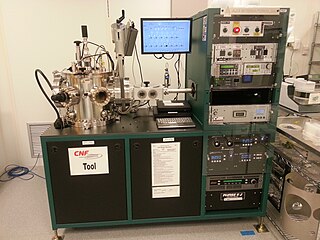
In physics, sputtering is a phenomenon in which microscopic particles of a solid material are ejected from its surface, after the material is itself bombarded by energetic particles of a plasma or gas. It occurs naturally in outer space, and can be an unwelcome source of wear in precision components. However, the fact that it can be made to act on extremely fine layers of material is utilised in science and industry—there, it is used to perform precise etching, carry out analytical techniques, and deposit thin film layers in the manufacture of optical coatings, semiconductor devices and nanotechnology products. It is a physical vapor deposition technique.
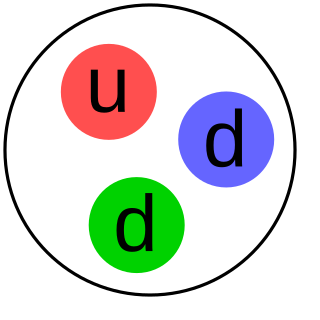
Neutron radiation is a form of ionizing radiation that presents as free neutrons. Typical phenomena are nuclear fission or nuclear fusion causing the release of free neutrons, which then react with nuclei of other atoms to form new isotopes—which, in turn, may trigger further neutron radiation. Free neutrons are unstable, decaying into a proton, an electron, plus an anti-electron-neutrino with a mean lifetime of 887 seconds.
Elastic Recoil Detection Analysis (ERDA), also referred to as forward recoil scattering, is an Ion Beam Analysis technique in materials science to obtain elemental concentration depth profiles in thin films. This technique is known by several different names. These names are listed below. In the technique of ERDA, an energetic ion beam is directed at a sample to be characterized and there is an elastic nuclear interaction between the ions of beam and the atoms of the target sample. Such interactions are commonly of Coulomb nature. Depending on the kinetics of the ions, cross section area, and the loss of energy of the ions in the matter, Elastic Recoil Detection Analysis helps determine the quantification of the elemental analysis. It also provides information about the depth profile of the sample.

Channelling is the process that constrains the path of a charged particle in a crystalline solid.

In nuclear and materials physics, stopping power is the retarding force acting on charged particles, typically alpha and beta particles, due to interaction with matter, resulting in loss of particle energy. Its application is important in areas such as radiation protection, ion implantation and nuclear medicine.
Gas cluster ion beams (GCIB) is a technology for nano-scale modification of surfaces. It can smooth a wide variety of surface material types to within an angstrom of roughness without subsurface damage. It is also used to chemically alter surfaces through infusion or deposition.

Sputter deposition is a physical vapor deposition (PVD) method of thin film deposition by sputtering. This involves ejecting material from a "target" that is a source onto a "substrate" such as a silicon wafer. Resputtering is re-emission of the deposited material during the deposition process by ion or atom bombardment. Sputtered atoms ejected from the target have a wide energy distribution, typically up to tens of eV. The sputtered ions can ballistically fly from the target in straight lines and impact energetically on the substrates or vacuum chamber. Alternatively, at higher gas pressures, the ions collide with the gas atoms that act as a moderator and move diffusively, reaching the substrates or vacuum chamber wall and condensing after undergoing a random walk. The entire range from high-energy ballistic impact to low-energy thermalized motion is accessible by changing the background gas pressure. The sputtering gas is often an inert gas such as argon. For efficient momentum transfer, the atomic weight of the sputtering gas should be close to the atomic weight of the target, so for sputtering light elements neon is preferable, while for heavy elements krypton or xenon are used. Reactive gases can also be used to sputter compounds. The compound can be formed on the target surface, in-flight or on the substrate depending on the process parameters. The availability of many parameters that control sputter deposition make it a complex process, but also allow experts a large degree of control over the growth and microstructure of the film.
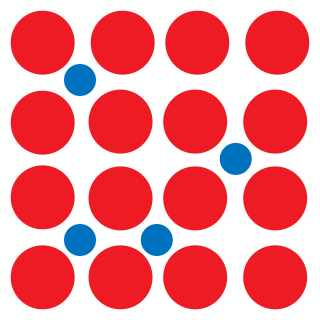
An interstitial defect is a type of point crystallographic defect where an atom of the same or of a different type, occupies a normally unoccupied site in the crystal structure. When the atom is of the same type as those already present they are known as a self-interstitial defect. Alternatively, small atoms in some crystals may occupy interstitial sites, such as hydrogen in palladium. Interstitials can be produced by bombarding a crystal with elementary particles having energy above the displacement threshold for that crystal, but they may also exist in small concentrations in thermodynamic equilibrium. The presence of interstitial defects can modify the physical and chemical properties of a material.
Ion beam mixing is the atomic intermixing and alloying that can occur at the interface separating two different materials during ion irradiation. It is applied as a process for adhering two multilayers, especially a substrate and deposited surface layer. The process involves bombarding layered samples with doses of ion radiation in order to promote mixing at the interface, and generally serves as a means of preparing electrical junctions, especially between non-equilibrium or metastable alloys and intermetallic compounds. Ion implantation equipment can be used to achieve ion beam mixing.
Rutherford backscattering spectrometry (RBS) is an analytical technique used in materials science. Sometimes referred to as high-energy ion scattering (HEIS) spectrometry, RBS is used to determine the structure and composition of materials by measuring the backscattering of a beam of high energy ions impinging on a sample.
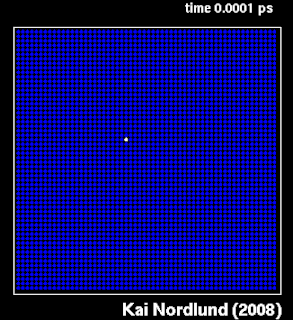
A collision cascade is a set of nearby adjacent energetic collisions of atoms induced by an energetic particle in a solid or liquid.
The threshold displacement energy is the minimum kinetic energy that an atom in a solid needs to be permanently displaced from its lattice site to a defect position. It is also known as "displacement threshold energy" or just "displacement energy". In a crystal, a separate threshold displacement energy exists for each crystallographic direction. Then one should distinguish between the minimum and average over all lattice directions threshold displacement energies. In amorphous solids it may be possible to define an effective displacement energy to describe some other average quantity of interest. Threshold displacement energies in typical solids are of the order of 10 - 50 eV.
Swift heavy ions are a special form of particle radiation for which electronic stopping dominates over nuclear stopping. They are accelerated in particle accelerators to very high energies, typically in the MeV or GeV range and have sufficient energy and mass to penetrate solids on a straight line. In many solids swift heavy ions release sufficient energy to induce permanently modified cylindrical zones, so-called ion tracks. If the irradiation is carried out in an initially crystalline material, ion tracks consist of an amorphous cylinder. Ion tracks can be produced in many amorphizing materials, but not in pure metals, where the high electronic heat conductivity dissipates away the electronic heating before the ion track has time to form.
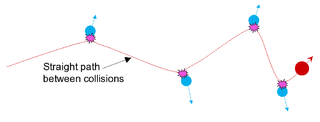
The binary collision approximation (BCA) signifies a method used in ion irradiation physics to enable efficient computer simulation of the penetration depth and defect production by energetic ions in solids. In the method, the ion is approximated to travel through a material by experiencing a sequence of independent binary collisions with sample atoms (nuclei). Between the collisions, the ion is assumed to travel in a straight path, experiencing electronic stopping power, but losing no energy in collisions with nuclei.
Radiation materials science describes the interaction of radiation with matter: a broad subject covering many forms of irradiation and of matter.
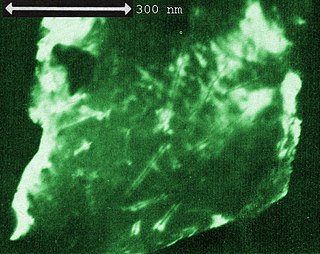
Ion tracks are damage-trails created by swift heavy ions penetrating through solids, which may be sufficiently-contiguous for chemical etching in a variety of crystalline, glassy, and/or polymeric solids. They are associated with cylindrical damage-regions several nanometers in diameter and can be studied by Rutherford backscattering spectrometry (RBS), transmission electron microscopy (TEM), small-angle neutron scattering (SANS), small-angle X-ray scattering (SAXS) or gas permeation.

Interatomic potentials are mathematical functions to calculate the potential energy of a system of atoms with given positions in space. Interatomic potentials are widely used as the physical basis of molecular mechanics and molecular dynamics simulations in computational chemistry, computational physics and computational materials science to explain and predict materials properties. Examples of quantitative properties and qualitative phenomena that are explored with interatomic potentials include lattice parameters, surface energies, interfacial energies, adsorption, cohesion, thermal expansion, and elastic and plastic material behavior, as well as chemical reactions.

The MIAMI facility is a scientific laboratory located within the Ion Beam Centre at the University of Huddersfield. This facility is dedicated to the study of the interaction of ion beams with matter. The facilities combine ion accelerators in situ with Transmission Electron Microscopes (TEM): a technique that allows real-time monitoring of the effects of radiation damage on the microstructures of a wide variety of materials. Currently the laboratory operates two such systems MIAMI-1 and MIAMI-2 that are the only facilities of this type in the United Kingdom, with only a few other such systems in the world. The MIAMI facility is also part of the UKNIBC along with the Universities of Surrey and Manchester, which provides a single point of access to a wide range of accelerators and techniques.
References
- 1 2 Biersack, J. P.; Haggmark, L. G. (1980). "A Monte Carlo computer program for the transport of energetic ions in amorphous targets". Nuclear Instruments and Methods . 174 (1–2): 257–269. Bibcode:1980NucIM.174..257B. doi:10.1016/0029-554X(80)90440-1.
- ↑ SRIM plus Linux over Wine (SRIM+(LINUX/WINE))
- ↑ SRIM Wine Page @WineHQ
- 1 2 3 4 Ziegler, J. F.; Biersack, J. P.; Littmark, U. (1985). The Stopping and Range of Ions in Matter. New York: Pergamon Press. ISBN 978-0-08-021607-2.
- ↑ "Particle interactions with matter" . Retrieved 17 August 2014.CS1 maint: discouraged parameter (link)
- ↑ Robinson, M.; Torrens, I. (1974). "Computer simulation of atomic-displacement cascades in solids in the binary-collision approximation". Physical Review B . 9 (12): 5008–5024. Bibcode:1974PhRvB...9.5008R. doi:10.1103/PhysRevB.9.5008.
- ↑ Was, G. (2013). Fundamentals of Radiation Materials Science. Springer.
- ↑ Smith, R., ed. (1997). Atomic & Ion Collisions in Solids and at Surfaces: Theory, Simulation and Applications . Cambridge, UK: Cambridge University Press. ISBN 978-0-521-44022-6.
- ↑ Robinson, M. T.; Oen, O. S. (1963). "The channeling of energetic atoms in crystal lattices". Applied Physics Letters . 2 (2): 30–32. Bibcode:1963ApPhL...2...30R. doi:10.1063/1.1753757.
- ↑ Averback, R. S.; Diaz de la Rubia, T. (1998). "Displacement Damage in Irradiated Metals and Semiconductors" (PDF). In Ehrenfest, H.; Spaepen, F. (eds.). Solid State Physics. 51. New York: Academic Press. pp. 281–402. doi:10.1016/S0081-1947(08)60193-9. ISBN 978-0-12-607751-3.
- ↑ Nordlund, K.; Ghaly, M.; Averback, R. S.; Caturla, M.; Diaz de la Rubia, T.; Tarus, J. (1998). "Defect production in collision cascades in elemental semiconductors and fcc metals". Physical Review B . 57 (13): 7556–7570. Bibcode:1998PhRvB..57.7556N. doi:10.1103/PhysRevB.57.7556.
- ↑ Partyka, P.; Zhong, Y.; Nordlund, K.; Averback, R. S.; Robinson, I. M.; Ehrhart, P. (2001). "Grazing incidence diffuse x-ray scattering investigation of the properties of irradiation-induced point defects in silicon". Physical Review B . 64 (23): 235207. Bibcode:2001PhRvB..64w5207P. doi:10.1103/PhysRevB.64.235207.
- ↑ Kirk, M. A.; Robertson, I. M.; Jenkins, M. L.; English, C. A.; Black, T. J.; Vetrano, J. S. (1987). "The collapse of defect cascades to dislocation loops". Journal of Nuclear Materials . 149 (1): 21–28. Bibcode:1987JNuM..149...21K. doi:10.1016/0022-3115(87)90494-6.
- ↑ Ruault, M. O.; Chaumont, J.; Penisson, J. M.; Bourret, A. (1984). "High resolution and in situ investigation of defects in Bi-irradiated Si". Philosophical Magazine A . 50 (5): 667–675. Bibcode:1984PMagA..50..667R. doi:10.1080/01418618408237526.
- ↑ Rashidian Vaziri, M. R.; Hajiesmaeilbaigi, F.; Maleki, M. H. (2010). "Microscopic description of the thermalization process during pulsed laser deposition of aluminium in the presence of argon background gas". Journal of Physics D . 43 (42): 425205. Bibcode:2010JPhD...43P5205R. doi:10.1088/0022-3727/43/42/425205.
- ↑ Henriksson, K. O. E.; Vörtler, K.; Dreißigacker, S.; Nordlund, K.; Keinonen, J. (2006). "Sticking of atomic hydrogen on the tungsten (001) surface" (PDF). Surface Science . 600 (16): 3167–3174. Bibcode:2006SurSc.600.3167H. doi:10.1016/j.susc.2006.06.001.
- ↑ Hopf, C.; von Keudell, A.; Jacob, W. (2003). "Chemical sputtering of hydrocarbon films". Journal of Applied Physics . 94 (4): 2373–2380. Bibcode:2003JAP....94.2373H. doi:10.1063/1.1594273.
- ↑ Vajda, P. (1977). "Anisotropy of electron radiation damage in metal crystals". Reviews of Modern Physics . 49 (3): 481–521. Bibcode:1977RvMP...49..481V. doi:10.1103/RevModPhys.49.481.